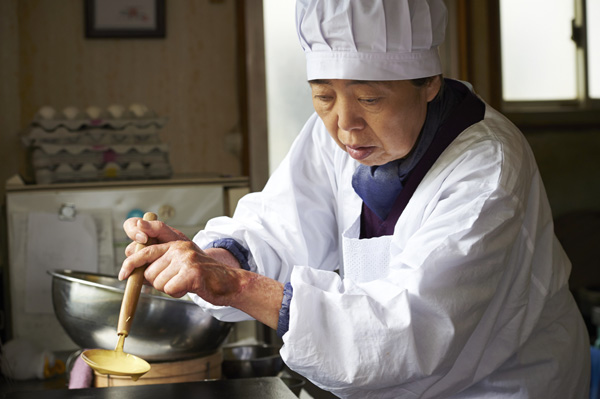The inimitable works of Japanese filmmaker Naomi Kawase are some of the most intensely beautiful in world cinema. Kawase, whose first films were personal documentaries focusing on herself and her family, puts a primacy on capturing the natural world and its effects on her characters. This lends her films an animistic sensibility that often overwhelms other considerations such as a clearly discernible narrative or motivations. As lovely as her movies are, and as acclaimed as they have been at film festivals, Kawase’s filmmaking methods tend to baffle many and even lead to hostile reactions in some quarters.
Perhaps this is why up until now none of her features have had American distribution. Also, Kawase’s films lack the fetishistic genre elements of outré action and extreme bizarreness often preferred by U.S. distributors of Japanese films. Kawase’s creations are too quiet, too contemplative, and perhaps too challenging, to encourage most distributors to take a chance on them.
This has changed with her latest film, Sweet Bean, which, while continuing her previous visual and thematic concerns, is a departure in significant ways. It marks the first time she has adapted a novel, in this case written by Durian Sukegawa; all her previous movies were based on self-written scripts and scenarios. Sweet Bean is also her first set in Tokyo; most of her earlier films took place in her native Nara.
The scenario, which is very much centered around food as well as tracking the actions of a charming, eccentric old lady (played with lovely grace by veteran actress Kirin Kiki), has elements which make it much more accessible to general audiences than her previous output, at least on the surface level. In fact, Sweet Bean proves to be an ideal entry point into Kawase’s filmography and may inspire some viewers to seek out her more challenging and personal films.
Sweet Bean, however, doesn’t derive its sole value in being more accessible than Kawase’s other films. It’s a lovingly made and wonderfully acted film in its own right, and while it may strike some as sentimental, it rightfully earns all the emotions it elicits, including, perhaps, tears.
The film opens with striking images of cherry blossoms. Though this is a familiar symbol of Japan, the brilliantly intense nature of these images connects it visually to the natural world in Kawase’s work. These cherry blossoms are a recurring visual motif, marking the passage of time, and providing symbolic import.
Most of Sweet Bean takes place in a bakery that sells dorayakis, a pancakelike pastry filled in the middle with a sweet red bean paste. (An, the Japanese word for this paste, is the film’s original title as well as that of its source novel.) The bakery is run by Sentaro (Masatoshi Nagase), a man who seems to spend most of his days in a depressive funk. He doesn’t derive much joy from making these pastries; it’s revealed later that he doesn’t even have much of a sweet tooth.
One day, Tokue (Kirin Kiki), a 76-year-old woman, comes to the bakery answering an ad Sentaro has placed seeking an assistant. Sentaro summarily rejects her. He feels her advanced age and her somewhat deformed hands would make her unable to handle the physical work required, which includes some heavy lifting. Also, Tokue at first strikes Sentaro as being somewhat off her rocker. However, Tokue is nothing if not persistent and continues asking Sentaro to work there, not even caring about the very low wages and the long hours the job requires.
What finally sells Sentaro on Tokue is when he gets a taste of her red bean paste. Blown away by its amazing quality, he quickly takes her on. However, what he doesn’t bargain for is Tokue’s insistence that all the red bean paste that he uses from now on be made entirely from scratch. Up until that point, Sentaro has been buying it in bulk from an outside vendor. Now, Tokue insists that they both rise at the crack of dawn and put in the many hours it takes to cook the red beans. This part of the film is dominated by long sequences that function as mini-documentaries on the art and craft of making an.
Sentaro’s business booms after he begins using Tokue’s homemade an; his customers notice the vast improvement in the quality of the product and begin lining up around the block for the dorayaki. Sentaro depressive mood lifts, and the emotional enrichment he gains from being around Tokue extends far beyond her culinary mastery. However, a secret from Tokue’s past rears its ugly head, forcing her to leave the shop and threatening Sentaro’s business.
Sweet Bean, with its long, lovingly shot sequences of the titular food (which will make viewers long for a taste immediately after viewing) fits perfectly in the genre of culinary-based films—with such famous examples as Babette’s Feast, Big Night, and Tampopo, just to name a few—in which food has metaphorical, cultural, and even spiritual significance. Kawase takes this admittedly familiar material and greatly transcends it with her singular attention to details of the natural world and its capacity for healing people who have been scorned and rejected by society. The lovely images—kudos to the impressive work of cinematographer Shigeki Akiyama—and the genuinely emotional revelations of the later scenes make for an intensely moving experience.
The central performances lend considerable gravitas and charismatic skill. Masatoshi Nagase (whom most American audiences will remember from Jim Jarmusch’s Mystery Train) is quite fine as the mysterious, taciturn man who becomes much more humanized as the layers of his painful past are peeled away.
But Sweet Bean truly belongs to Kirin Kiki, one of Japan’s greatest actresses, who has been doing superior work for decades and contributes one of her finest performances here. She is the heart of this film, in much the same way as an is the key ingredient of dorayakis. The weight and wisdom of her many years comes through in every word and gesture, and it is exquisite to watch.

















Leave A Comment